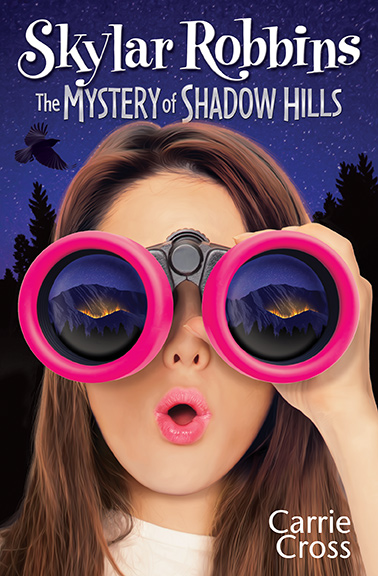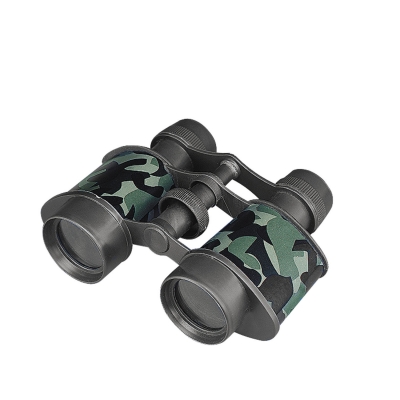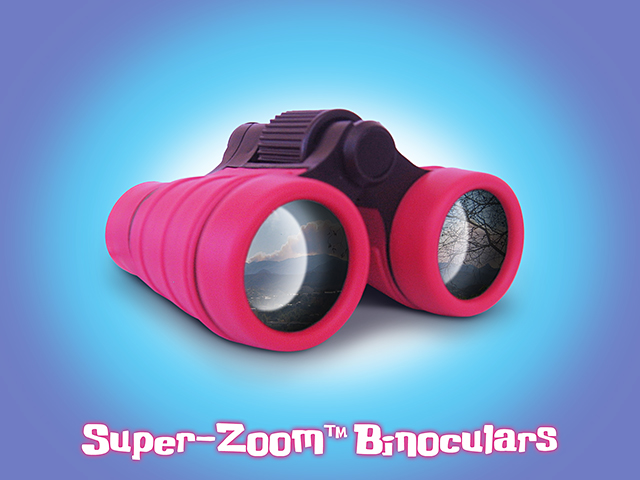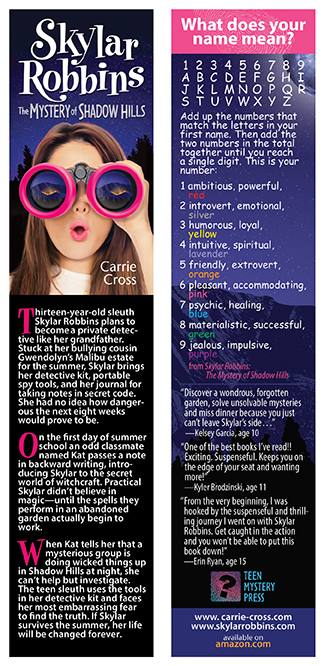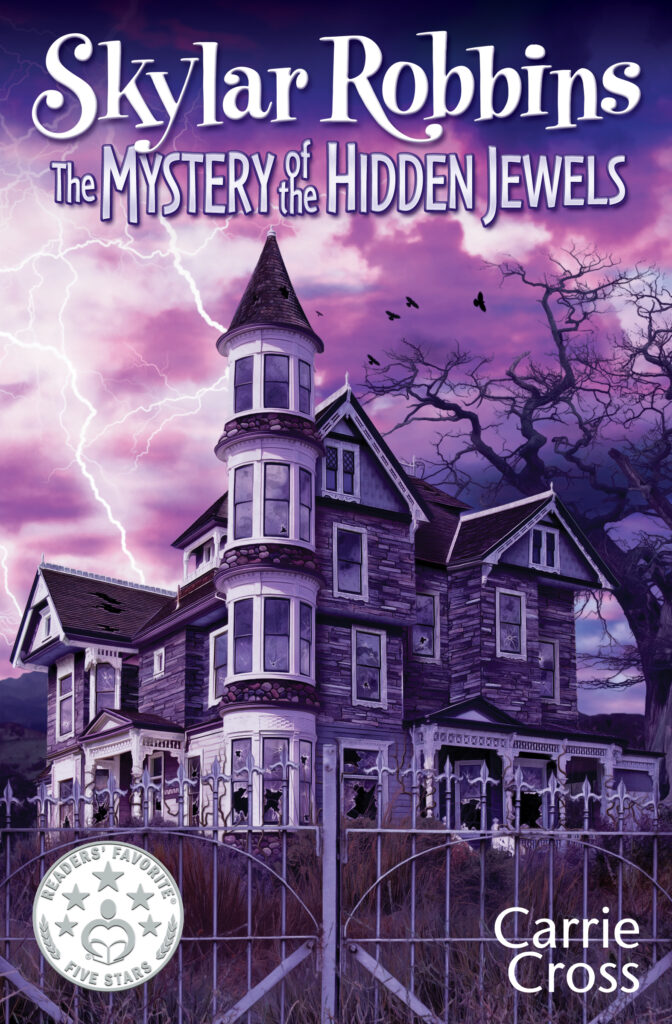Interview with Carrie Cross
Posted by: Allison on: May 24, 2014
Carrie Cross is an avid reader who fell in love with books as a little girl after reading Goodnight Moon. Her absolute most-loved books are the ones she read in her ‘tweens. Cross has great memories of lying in bed on stormy nights reading Are You There God? It’s Me, Margaret, Harriet the Spy, The Changeling, and Nancy Drew mysteries.
Writing is her favorite creative process. Cross has loved words since she was a little kid. She also wrote her first “book” at age four: Blackie the Little Black Dog and the Flying Washing Machine. Since books for this age group were the most fun to read, she thought as an adult that they would also be the most enjoyable to write.
According to her About, her inspiration for the Skylar Robbins’ mysteries comes from an incident when she was six years old. Cross played hide-and-seek with the little girl who lived in a creepy two-story in Santa Monica Canyon. There were closets and secret hiding places with doors that opened into other rooms. Later, she wondered, “What if there was a clue hidden in one of those closets?” Skylar is modeled on her mom, a strong woman who faced fears head on. The fingerprint illustrations are from actual jpeg images which Cross found online and that her husband recreated in Adobe Illustrator to give them a more kid-friendly feel.
In addition to writing mysteries and reading, Carrie loves to cook, hike at the beach, go boating, and travel. I posted a review yesterday of The Mystery of Shadow Hills.
ALLISON: Were you an only child or one of a sibling group? How did that impact the kind of adventures you experienced during your childhood?
CARRIE: I am an only child, so when I wasn’t spending time with friends I had to entertain myself, and loved to do anything creative. When I was about ten I got my first guitar. I taught myself chords out of a book and wrote songs I would sing with my friends, trying out simple harmonies. I also enjoyed making art projects like creating faux stained glass windows with liquid lead and glass stain. I’d hunt through the field behind our house for pretty rocks and paint them with clear nail polish to make paperweights. And of course, one of my favorite creative pastimes was writing. Besides writing songs, I penned poems and short stories in elementary school, and then I made my first attempt at a novel in junior high. I wrote an adult novel after college that was never published, and then decided I wanted to try writing a middle grade mystery. Teen Mystery Press published Skylar Robbins: The Mystery of Shadow Hills in June 2013, and the sequel, The Mystery of The Hidden Jewels, comes out this summer.
ALLISON: Who served as your role model during your adolescence?
CARRIE: Definitely my mom, the late Sylvia Cross. I always try to emulate her leadership and strength of character. She had a quote from Calvin Coolidge hanging over the desk in her study where I used to do my homework, and it has remained my motto to this day: “Persistence and determination alone are omnipotent.” As president of the Women’s National Book Association, my mom took the organization to new heights, winning the respect of all of the chapter presidents. She was a mentor to many friends and coworkers. People still tell me that when faced with a problem or dilemma they ask themselves, “What would Sylvia have done?” What a nice compliment! I learned to be a good listener from my mom, and like her, I’m a friend people turn to for advice.
ALLISON: You lived in Malibu for eight years. What were your favorite activities there?
CARRIE: Walking on the beach, photographing my husband while he surfed, hiking in the hills overlooking the ocean, body surfing, and exploring caves. One of my favorite scenes in Skylar Robbins: The Mystery of Shadow Hills takes place in the caves on Malibu Beach. Skylar’s new friend Kat challenges her to search three caves at midnight to search for seeds she promises will grow into gems.
“Sky,” Kat cried suddenly, pointing across the black sand. “Look. There they are.” I was more concerned about the rising tide, and looked out over the dark rumbling ocean. White spray flew up in the air as another huge wave crashed nearby. So loud it sounded like a refrigerator fell off a tall building and landed right next to us. I hurried after Kat as the water rushed forward. “This is it. Three caves.” Moonlight cast shadows behind the boulders that guarded the entrance. We darted around them and climbed under the rock arch.
The dark cave stunk of washed-up kelp, dank and rotten. I shuffled forward on the damp sand with my hands out in front of me like a sleepwalker, hoping I wouldn’t stumble over a rock or bash into a wall. I pulled out my flashlight and turned it on. As soon as its beam lit up the cave, heavy flies woke up, buzzing around the seaweed and bonking into my face. I ducked, swatting them away. Kat hurried past me and rushed toward the back of the cave, peering at the ground. Suddenly she cried, “Sky—here they are. I found the gem seeds!” Hidden between the boulders, disguised as wet pebbles, shining gem seeds winked up at us.
ALLISON: What is the most mysterious incident you can remember from growing up?
CARRIE: When I was six years old, my parents decided we needed to buy a bigger house. We looked at a creepy two-story in Santa Monica Canyon, and I played hide-and-seek with the little girl who lived there. I remember disappearing into closets and secret hiding places with doors that opened into other rooms. Later, I wondered, “What if there was a clue hidden in one of those closets? Or what if a cupboard door opened into a long, dark tunnel, with a big surprise at the other end?” I never forgot that house, and it was the inspiration for my second book, The Mystery of the Hidden Jewels.
ALLISON: What inspired you to write a mystery series?
CARRIE: I’ve always loved mysteries and stories about spies and sleuths. I read Nancy Drew and The Happy Hollisters as a kid, and loved Harriet the Spy. Another one of my favorite authors when I was younger was Judy Blume. So I thought, what if I could come up with a teen sleuth series and integrate some of the coming-of-age themes I loved to read about when I was a tween? That 13-year-old sleuth is Skylar Robbins. I’ve also always been interested in witchcraft, and wanted to weave that theme into my first detective story. So I decided to pit a teen witch against that young sleuth to kick off the first book in the series: Skylar Robbins: The Mystery of Shadow Hills. One reviewer described it as, “Nancy Drew meets Harry Potter.”
ALLISON: Your bio says that you “look for clues in unexpected places”. What is the most unusual clue you have found?
CARRIE: It has been a long time since I have found a mysterious clue myself. However after reading my first book, more than one group of girls formed their own detective agencies. Girls Secret Agency in Oregon combed their school for clues and posted them on Skylar’s Facebook page along with their analysis of what each clue meant. Here is a picture of their most unusual clue:
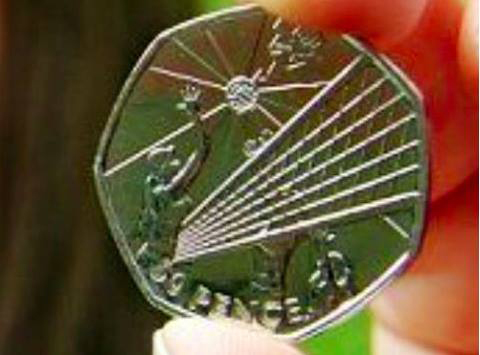
ALLISON: Why did you decide to write for middle school?
CARRIE: My absolute favorite books of all time were the ones I read in my tweens. I have great memories of lying in bed on stormy nights reading Are You There God? It’s Me, Margaret, The Changeling, The Velvet Room, Nancy Drew mysteries, and Harriet the Spy, while I listened to raindrops hitting the metal sill outside my window. Since books for this age group were the most fun to read, I thought that they would also be the most fun to write.
ALLISON: This is the time when boys often stop reading books. Any plans to feature males to entice this audience?
CARRIE: Skylar is such a gusty heroine that I think she’s appealing to both boys and girls. Also, several of the main characters in the Skylar Robbins mysteries are boys, so I think the series will entice the male audience. I gave preview copies to a lot of my coworkers’ and customers’ kids to read before I was published so I could get honest feedback. Several of these kids were boys, and I was elated when I heard that they enjoyed the mystery as much as the girls did. Here’s a quote I got from one boy’s mom: “My 11-year-old son started reading the manuscript last night & couldn’t put it down…we finally had to take it away & turn the lights out. He keeps raving about how detailed & descriptive the book is.”
One group of brothers started their own detective agency: Wilkerson Boys, PI. Their mom is a photographer and took this picture while they were on the beach hunting for clues:
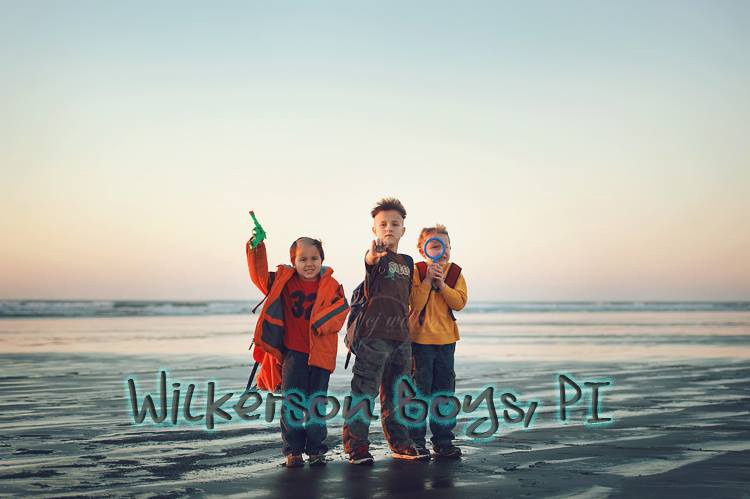 ALLISON: Skylar’s new friend in the book associates herself with Wicca. Did you have any concerns about the negative reaction this might cause of some parents?
ALLISON: Skylar’s new friend in the book associates herself with Wicca. Did you have any concerns about the negative reaction this might cause of some parents?
CARRIE: Skylar Robbins would never participate in black magic since she’s an ethical girl with integrity. But I needed her to be involved with magic in the story. What tween girl wouldn’t want to experiment with witchcraft if the outcome could be charming a cute boy or growing her own diamonds? I don’t want to reveal too much of the plot, but by the end of the book, Skylar exposes most of the Wiccan characters as charlatans. Moms and librarians have given the book a 5-star rating and their seal of approval, so I’m pretty sure parents will be happy with the outcome of the book and Skylar’s conclusions.
ALLISON: How has your husband supported you?
CARRIE: My husband has supported me in every way. He’s a graphic artist and designed the book’s cover, which won an award for best cover design. We bought an image of a young girl from a stock photography site and Ed used various techniques to tweak it and make her resemble my description of Skylar from the novel. I can’t pass up the opportunity to give him a shameless plug: His website is Mental Ward Design. Also, he’s a great editor and gave me excellent constructive criticism on everything from plot to punctuation.
ALLISON: What’s next?
CARRIE: At the end of The Mystery of Shadow Hills, Skylar sends a message to the readers: The Skylar Robbins Detective Agency needs a few secret agents to help solve her next case, The Mystery of the Hidden Jewels (summer, 2014). But they must have mad detective skills! They need to decipher her web address by using a mirror if they haven’t yet learned to read backward. Then find the Secret Agent Application form, and decode their password using a code they learned in the book. The second mystery is interactive: Skylar’s secret agents will help her figure out what the clues mean by posting their guesses on her website. Skylar’s adventures will continue in The Mystery of the Missing Heiress (2015) and The Curse of Koma Island (TBA). Updates, clues, and games are available on Skylarrobbins.com, and more secret agents are welcome to join the fun!

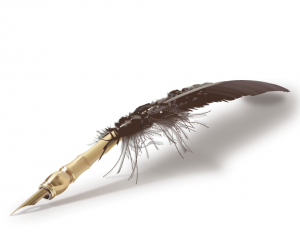
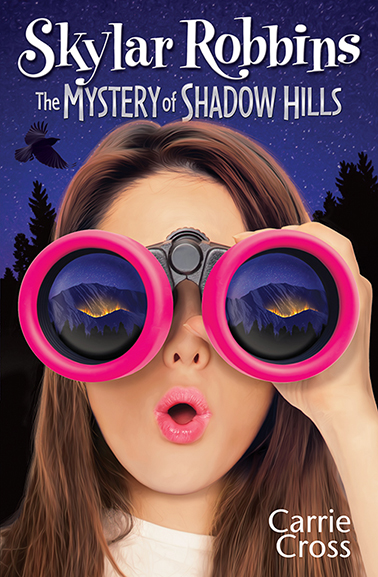 Care to trade a review for a free copy of my book? Please check it out here if you would like to post a review: http://www.instafreebie.com/book/518
Care to trade a review for a free copy of my book? Please check it out here if you would like to post a review: http://www.instafreebie.com/book/518
